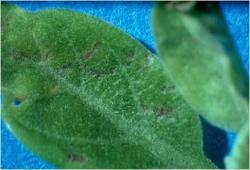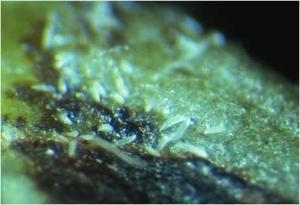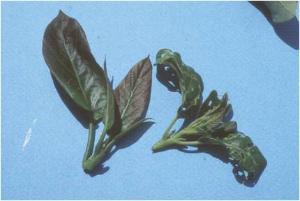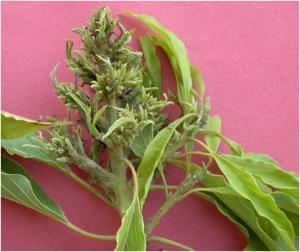Tropical Entomology - Avocado Bud Mite
Tegolophus perseaflorae (K) (Acari: Eriophydae)
-
Description
The adult avocado bud mite has a yellowish appearance. Its life cycle has not been determined. Avocado bud mite populations begin to increase from March to May (Peña and Johnson, 1999).
-
Damage

Part of plant damaged: Leaves, buds
In Florida, the avocado bud mites were observed feeding on buds, causing necrotic spots on apical leaves, and subcircular, irregular openings on mature leaves. Mites were also found in petioles, the underside of leaves and fruitlets. This mite is also reported to feed on the peduncle, calyx and stylar area (Medina et al. 1978, Jeppson et al. 1975). -
Management
Monitoring
Mites are occasional pests in some orchards and are seldom observed in others. Periodic inspections are recommended during December, January and February using a hand lens.
Chemical Control
In Florida, few miticides are registered for use on avocados when fruit is present. Sulfur or oil emulsion sprays are recommended (Peña and Johnson, 1999).
Fact Sheets
- Updated list of insecticides labeled for Florida avocado production
- Peña, J. E., Duncan, R. E., Klema, E., Hunsberger, A. 1999. Evaluation of direct and indirect action of insecticides and acaricides for control of lime and avocado pests. Proc. Fla. State Hort. Soc. 112: 213-217.
- 1999. Peña et al..pdf
-
References
- Peña, J., and Johnson, F. (1999). Insect management of avocados. Insect Management Guide, Department of Entomology and Nematology, Florida Cooperative Extension Service, University of Florida; http://edis.ifas.ufl.edu/Body_IG068
- Vargas, R., and Rodriguez, S. (2008) Avocado red mite, Oligonychus yothersi (McGregor) In :Manejo de plagas en paltos y cítricos, Ripa, R., and P. Larral (eds) Instituto de Investigaciones Agropecuarias, Ministerio de Agricultura, La Cruz, Chile, Colleccion de Libros INIA 23, 239-246.
-
Images

Avocado bud mite

Damage caused by avocado bud mite

Bud damage caused by avocado bud mite

